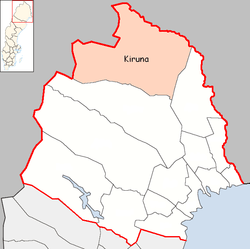Kiruna Municipality
| Kiruna Municipality Kiruna kommun | ||
|---|---|---|
| Municipality | ||
| ||
 | ||
| Coordinates: 67°51′N 020°13′E / 67.850°N 20.217°ECoordinates: 67°51′N 020°13′E / 67.850°N 20.217°E | ||
| Country | Sweden | |
| County | Norrbotten County | |
| Seat | Kiruna | |
| Area[1] | ||
| • Total | 20,551.42 km2 (7,934.95 sq mi) | |
| • Land | 19,140.33 km2 (7,390.12 sq mi) | |
| • Water | 1,411.09 km2 (544.82 sq mi) | |
| Area as of January 1, 2014. | ||
| Population (June 30, 2016)[2] | ||
| • Total | 23,185 | |
| • Density | 1.1/km2 (2.9/sq mi) | |
| Time zone | CET (UTC+1) | |
| • Summer (DST) | CEST (UTC+2) | |
| ISO 3166 code | SE | |
| Province | Lapland | |
| Municipal code | 2584 | |
| Website | www.kiruna.se | |
Kiruna Municipality (Swedish: Kiruna kommun, Finnish: Kiirunan kunta, Northern Sami: Girona gielda) is a municipality in Norrbotten County in northernmost Sweden. Its seat is located in Kiruna. It is the northernmost municipality in Sweden, and at 20,715 square kilometres (7,998 sq mi) is Sweden's geographically largest covering roughly 4.604% of its total area.
Finnish, Meänkieli and Sami have the official status of being minority languages in the municipality.
During the 20th century the mining settlement Kiruna was built in the parish of Jukkasjärvi, at that time a rural municipality in very remote territory. A so-called municipalsamhälle (which was a kind of borough established within a rural municipality to take care of some matters of urban character) was instituted in 1908. The settlement grew (it even had a tramway system) and it was decided to make it a city. On January 1, 1948 the whole parish of Jukkasjärvi was transformed into the City of Kiruna. As the vast wilderness around the town itself was included, Kiruna was at that time regarded as the largest city municipality in the world. Only a few more cities were instituted in Sweden, the last one in 1951. Instead the differences between the three types of municipalities were diminished and finally abolished altogether. In 1971 Kiruna, as all others, became a unitary municipality and at the same time merged with Karesuando.
Geography
Kebnekaise is Sweden's and Sápmi's highest mountain at 2,104 metres above mean sea level. There are more than 6,000 lakes in Kiruna municipality, Lake Torneträsk being the largest. Seven rivers run through the municipality, named Kalix River, Torne River, Lainio River, Rautas River and Vittangi River, as well as Könkämä River and Muonio River which mark the border to Finland. The untouched geography has also been noted with the establishment of Abisko National Park, by the Norwegian border, established as early as 1909.
Localities
There are seven localities (or urban areas) in Kiruna Municipality:[3]
| # | Locality | Population |
|---|---|---|
| 1 | Kiruna | 18,154 |
| 2 | Vittangi | 789 |
| 3 | Jukkasjärvi | 519 |
| 4 | Svappavaara | 394 |
| 5 | Kuttainen | 364 |
| 6 | Karesuando | 313 |
| 7 | Övre Soppero | 220 |
The municipal seat in bold
Sister city
Kiruna Municipality has one sister city:
Notable native
- Börje Salming, Swedish ice hockey player
References
- ↑ "Statistiska centralbyrån, Kommunarealer den 1 januari 2014" (Microsoft Excel) (in Swedish). Statistics Sweden. Retrieved 2014-04-18.
- ↑ "Folkmängd i riket, län och kommuner 30 juni 2016" (in Swedish). Statistics Sweden. August 17, 2016. Retrieved August 17, 2016.
- ↑ Statistics Sweden as of December 31, 2005
External links
| Wikimedia Commons has media related to Kiruna Municipality. |
- Kiruna Municipality – Official site
